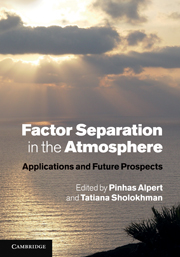Book contents
- Frontmatter
- Contents
- List of contributors
- Foreword
- Preface
- 1 Introduction
- 2 The Factor Separation Methodology and the fractional approach
- 3 Investigation of the Factor Separation features for basic mathematical functions
- 4 Factor Separation Methodology and paleoclimates
- 5 Meso-meteorology: Factor Separation examples in atmospheric meso-scale motions
- 6 Using the Alpert–Stein Factor Separation Methodology for land-use land-cover change impacts on weather and climate process with the Regional Atmospheric Modeling System
- 7 Application of Factor Separation to heavy rainfall and cyclogenesis: Mediterranean examples
- 8 Experience in applying the Alpert–Stein Factor Separation Methodology to assessing urban land-use and aerosol impacts on precipitation
- 9 Free and forced thermocline oscillations in Lake Tanganyika
- 10 Application of the Factor Separation Methodology to quantify the effect of waste heat, vapor and pollution on cumulus convection
- 11 The use of the Alpert–Stein Factor Separation Methodology for climate variable interaction studies in hydrological land surface models and crop yield models
- 12 Linear model for the sea breeze
- 13 Experience and conclusions from the Alpert–Stein Factor Separation Methodology
- 14 Tagging systematic errors arising from different components of dynamics and physics in forecast models
- 15 Some difficulties and prospects
- 16 Summary
- Appendix: References employing the Alpert–Stein Factor Separation Methodology
- References
- Index
10 - Application of the Factor Separation Methodology to quantify the effect of waste heat, vapor and pollution on cumulus convection
Published online by Cambridge University Press: 03 May 2011
- Frontmatter
- Contents
- List of contributors
- Foreword
- Preface
- 1 Introduction
- 2 The Factor Separation Methodology and the fractional approach
- 3 Investigation of the Factor Separation features for basic mathematical functions
- 4 Factor Separation Methodology and paleoclimates
- 5 Meso-meteorology: Factor Separation examples in atmospheric meso-scale motions
- 6 Using the Alpert–Stein Factor Separation Methodology for land-use land-cover change impacts on weather and climate process with the Regional Atmospheric Modeling System
- 7 Application of Factor Separation to heavy rainfall and cyclogenesis: Mediterranean examples
- 8 Experience in applying the Alpert–Stein Factor Separation Methodology to assessing urban land-use and aerosol impacts on precipitation
- 9 Free and forced thermocline oscillations in Lake Tanganyika
- 10 Application of the Factor Separation Methodology to quantify the effect of waste heat, vapor and pollution on cumulus convection
- 11 The use of the Alpert–Stein Factor Separation Methodology for climate variable interaction studies in hydrological land surface models and crop yield models
- 12 Linear model for the sea breeze
- 13 Experience and conclusions from the Alpert–Stein Factor Separation Methodology
- 14 Tagging systematic errors arising from different components of dynamics and physics in forecast models
- 15 Some difficulties and prospects
- 16 Summary
- Appendix: References employing the Alpert–Stein Factor Separation Methodology
- References
- Index
Summary
Large oil refineries emit heat, vapor, and cloud condensation nuclei (CCN), all of which can affect the formation of cloud and precipitation. The Factor Separation (FS) technique is applied to isolate the net contributions of waste heat, vapor, and CCN to the rainfall of a cumulus developing in the industrial plume. The mutualinteractive contributions of two or three of the factors are also computed. The model simulations indicate that the sensible heat provides the major stimulus for cloud development and rain formation. The pure contribution of the industrial CCN is to enhance the condensation causing an increase in the mass of total cloud water. The contributions arising from mutual interactions among two or three factors are quite large and should not be neglected. Particularly, the synergistic interaction of the sensible heat and pollution effects contribute towards the accumulated rainfall.
Introduction
There is considerable interest in the effects of large electrical power plants and oil refineries on meteorological phenomena. Preferential cumulus formation has been observed above electrical power plants and oil refineries (Auer, 1976). Hobbs et al. (1970) reported that in regions adjacent to or downwind of the Port Townsend paper mill (Washington State, USA) the annual rainfall recorded was 30% greater than the rainfall from nearby stations. This dramatic increase in annual precipitation is likely caused by the presence of the paper mill. Hobbs et al. speculated that the enhanced rainfall might be attributed to the large and giant CCN emitted from the paper mill into the pollution plume. Support for this hypothesis came from Eagan et al.'s (1974) study.
- Type
- Chapter
- Information
- Factor Separation in the AtmosphereApplications and Future Prospects, pp. 163 - 170Publisher: Cambridge University PressPrint publication year: 2011
- 1
- Cited by



